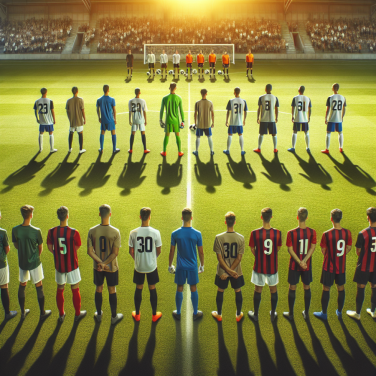Tracing the Ball Back in Time: Early Roots of Soccer
Soccer, a game loved and celebrated worldwide, traces its roots back centuries. Unbeknownst to many, the traditional dribbling, passing and shooting game we know today has origins that reach deep into human history, in different parts of the globe.
The inception of the sport can be traced back to ancient civilizations. The earliest forms of soccer were played in China around 200 B.C. during the Han Dynasty. It was known as 'Tsu Chu' which translates to 'kicking the ball'. This involved soldiers who used a leather ball filled with feathers and hair. The game was primarily used as a training method for the military, and had elements of what we would now recognize as soccer and rugby.
Simultaneously, similar games were also being played in other parts of the world. In ancient Rome, a game known as 'Harpastum' was popular. It was more physical than Tsu Chu, and required heavier and harder balls. The aim of Harpastum was to carry or throw a small ball over the opponents' line, evocative of the rough-on-the-edges early forms of modern football.
The Middle Ages in Britain saw another incarnation of the game, taking a somewhat less civilized form. It was known as 'Mob Football', involving an unlimited number of players, and was more of a riotous struggle than a structured game. The primary aim was to wrestle the ball to the designated spots. This led to the creation of laws limiting its play within the country.
While these forms of the game were unfolding, Central American civilizations like the Aztecs and Mayans also had similarly structured games. They played a game named 'Pok-A-Tok', which even involved elements of basketball. It had two teams attempting to strike a ball without using hands on vertical hoops attached to walls on opposite sides of a court.
Football in its modern form started shaping in the 19th century in England. Its formal codification happened in 1863 with the formation of the Football Association in England. This not only standardized the rules but also distinguished it from Rugby Football.
Progressing into the 20th century, soccer started gaining international acclaim. FIFA (Fédération Internationale de Football Association) was founded in 1904, and by mid-century, the introduction of World Cup and European Championships catapulted the sport into global stardom.
Read also:
Crypto Cash-Ins: The New Norm for eSports Stars
From Ancient To Modern: How Soccer Evolved Over Centuries
The inception of soccer dates back over 2,000 years. The primitive versions of the sport had little in common with the game we know today, but over centuries, soccer has transformed and morphed into the world's most popular sport.
The earliest versions of soccer can be traced back to the civilizations of ancient China around 2nd and 3rd centuries BC. A sport known as Cuju, which closely resembles modern-day soccer, was prevalent during this time. Cuju involved kicking a leather ball into a small hole, signifying a primitive form of goal. However, unlike today's sport, there were no goalkeepers.
In ancient Greece and Rome, a similar game was also played. The Greeks labeled it as 'Episkyros' and the Romans called it 'Harpastum'. These games involved more physicality and were more violent in comparison to the modern versions. Despite the brutality, the basis of teamwork, passing, and goal scoring began to take form.
In medieval England, soccer games would involve entire villages and towns and run the length of the day. In these versions of soccer, there was a lack of defined rules, often resulting in violent and chaotic game-play. It wasn't until 1863 that the English Football Association (FA) was formed, outlining the official rules and turning the chaotic game-play into an orderly sport.
The transition from ancient and medieval forms to modern soccer was significantly influenced by European industry and social reform. The Industrial Revolution saw a surge in the popularity of soccer due to increased leisure time for workers. The standardization of rules, creation of professional leagues, and investment in infrastructure facilitated the transformation of soccer into a modern team sport.
In the late 19th and early 20th centuries, soccer began to witness standardization of minimal physical contact and more tactical game-play. The first official FIFA World Cup, held in Uruguay in 1930, marked a new era for international competition.
The introduction of technology to soccer is another defining factor in the evolution of the sport. In the 1966 World Cup, refereeing errors led to debate over the introduction of goal-line technology, which was eventually adopted globally. The introduction of the Video Assistant Referee (VAR) system in recent years has stirred controversy yet again, but undeniably holds a pivotal role in the future development of the sport.
In conclusion, it is without a doubt that soccer has undergone significant changes since its primitive forms.




